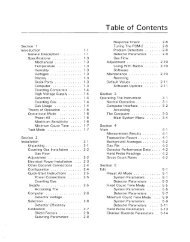Medical Physics Hand.. - Voss Associates
Medical Physics Hand.. - Voss Associates
Medical Physics Hand.. - Voss Associates
You also want an ePaper? Increase the reach of your titles
YUMPU automatically turns print PDFs into web optimized ePapers that Google loves.
Strontium-89 (50 d)*: Very effective in reducing the pain ofprostate and bone cancer. Beta emitter.Technetium-99m (6 h): Used in to image the skeleton andheart muscle in particular, but also for brain, thyroid, lungs(perfusion and ventilation), liver, spleen, kidney (structure andfiltration rate), gall bladder, bone marrow, salivary andlacrimal glands, heart blood pool, infection and numerousspecialized medical studies. Produced from Mo-99 in agenerator.Xenon-133 (5 d)*: Used for pulmonary (lung) ventilationstudies.Ytterbium-169 (32 d): Used for cerebrospinal fluid studies inthe brain.Ytterbium-177 (1.9 h): Progenitor of Lu-177.Yttrium-90 (64 h)*: Used for cancer brachytherapy and assilicate colloid for the relieving the pain of arthritis in largersynovial joints. Pure beta emitter and of growing significancein therapy.Radioisotopes of cesium, gold and ruthenium are also used inbrachytherapy.* fission productCyclotron RadioisotopesCarbon-11, Nitrogen-13, Oxygen-15, Fluorine-18: These arepositron emitters used in PET for studying brain physiologyand pathology, in particular for localising epileptic focus, andin dementia, psychiatry and neuropharmacology studies.They also have a significant role in cardiology. F-18 in FDG(fluorodeoxyglucose) has become very important in detectionof cancers and the monitoring of progress in their treatment,using PET.21Strontium-89 (50 d)*: Very effective in reducing the pain ofprostate and bone cancer. Beta emitter.Technetium-99m (6 h): Used in to image the skeleton andheart muscle in particular, but also for brain, thyroid, lungs(perfusion and ventilation), liver, spleen, kidney (structure andfiltration rate), gall bladder, bone marrow, salivary andlacrimal glands, heart blood pool, infection and numerousspecialized medical studies. Produced from Mo-99 in agenerator.Xenon-133 (5 d)*: Used for pulmonary (lung) ventilationstudies.Ytterbium-169 (32 d): Used for cerebrospinal fluid studies inthe brain.Ytterbium-177 (1.9 h): Progenitor of Lu-177.Yttrium-90 (64 h)*: Used for cancer brachytherapy and assilicate colloid for the relieving the pain of arthritis in largersynovial joints. Pure beta emitter and of growing significancein therapy.Radioisotopes of cesium, gold and ruthenium are also used inbrachytherapy.* fission productCyclotron RadioisotopesCarbon-11, Nitrogen-13, Oxygen-15, Fluorine-18: These arepositron emitters used in PET for studying brain physiologyand pathology, in particular for localising epileptic focus, andin dementia, psychiatry and neuropharmacology studies.They also have a significant role in cardiology. F-18 in FDG(fluorodeoxyglucose) has become very important in detectionof cancers and the monitoring of progress in their treatment,using PET.21Strontium-89 (50 d)*: Very effective in reducing the pain ofprostate and bone cancer. Beta emitter.Technetium-99m (6 h): Used in to image the skeleton andheart muscle in particular, but also for brain, thyroid, lungs(perfusion and ventilation), liver, spleen, kidney (structure andfiltration rate), gall bladder, bone marrow, salivary andlacrimal glands, heart blood pool, infection and numerousspecialized medical studies. Produced from Mo-99 in agenerator.Xenon-133 (5 d)*: Used for pulmonary (lung) ventilationstudies.Ytterbium-169 (32 d): Used for cerebrospinal fluid studies inthe brain.Ytterbium-177 (1.9 h): Progenitor of Lu-177.Yttrium-90 (64 h)*: Used for cancer brachytherapy and assilicate colloid for the relieving the pain of arthritis in largersynovial joints. Pure beta emitter and of growing significancein therapy.Radioisotopes of cesium, gold and ruthenium are also used inbrachytherapy.* fission productCyclotron RadioisotopesCarbon-11, Nitrogen-13, Oxygen-15, Fluorine-18: These arepositron emitters used in PET for studying brain physiologyand pathology, in particular for localising epileptic focus, andin dementia, psychiatry and neuropharmacology studies.They also have a significant role in cardiology. F-18 in FDG(fluorodeoxyglucose) has become very important in detectionof cancers and the monitoring of progress in their treatment,using PET.21Strontium-89 (50 d)*: Very effective in reducing the pain ofprostate and bone cancer. Beta emitter.Technetium-99m (6 h): Used in to image the skeleton andheart muscle in particular, but also for brain, thyroid, lungs(perfusion and ventilation), liver, spleen, kidney (structure andfiltration rate), gall bladder, bone marrow, salivary andlacrimal glands, heart blood pool, infection and numerousspecialized medical studies. Produced from Mo-99 in agenerator.Xenon-133 (5 d)*: Used for pulmonary (lung) ventilationstudies.Ytterbium-169 (32 d): Used for cerebrospinal fluid studies inthe brain.Ytterbium-177 (1.9 h): Progenitor of Lu-177.Yttrium-90 (64 h)*: Used for cancer brachytherapy and assilicate colloid for the relieving the pain of arthritis in largersynovial joints. Pure beta emitter and of growing significancein therapy.Radioisotopes of cesium, gold and ruthenium are also used inbrachytherapy.* fission productCyclotron RadioisotopesCarbon-11, Nitrogen-13, Oxygen-15, Fluorine-18: These arepositron emitters used in PET for studying brain physiologyand pathology, in particular for localising epileptic focus, andin dementia, psychiatry and neuropharmacology studies.They also have a significant role in cardiology. F-18 in FDG(fluorodeoxyglucose) has become very important in detectionof cancers and the monitoring of progress in their treatment,using PET.21













